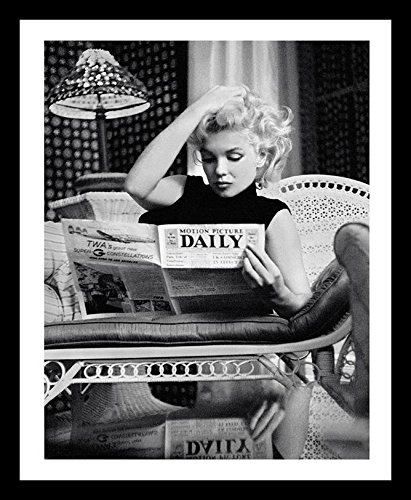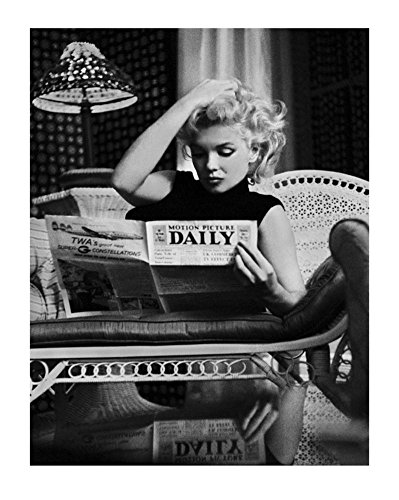Ed Feingersh (1925-1961) studied photography under Alexey Brodovitch at the New School of Social Research. Later, he worked for Pix Publishing as a photojournalist. His talent for available light photography under seemingly impossible conditions was well recognised. His pictures of Marilyn Monroe are his best known, but he was a prolific photojournalist throughout the 1950s. Edward Steichen selected two of his dark photographs of jazz musicians for MoMA’s annual The Family of Man exhibit.
Table of Contents
- 1 Career
- 1.1 Buyartforless Framed Marilyn Monroe Reading Motion Picture Daily 1955 by Ed Feingersh 20x16 Photograph Art Print Poster
- 1.2 Marilyn Monroe - Chanel No. 5 Poster Print by Ed Feingersh (24 x 32)
- 1.3 Marilyn Monroe Reading Motion Picture Daily, New York, c.1955 Art Print by Ed Feingersh 16 x 20in
- 1.4 Framed Wall Art Print Marilyn Monroe, Chanel No. 5 by Ed Feingersh 28.4 x 35.9 in.
- 1.5 Liquid I.V. Hydration Multiplier - Lemon Lime - Hydration Powder Packets | Electrolyte Supplement Drink Mix | Low Sugar | Easy Open Single-Serving Stick | Non-GMO (Lemon Lime/16 Count)
- 1.6 Prime Labs - Men's Test Booster - Natural Stamina, Endurance and Strength Booster - 60 Caplets
- 1.7 MegMan Natural Male Performance Energy and Strength Booster 10 Blue Capsules
- 1.8 NOW Supplements, L-Arginine 1,000 mg, Nitric Oxide Precursor, Amino Acid, 120 Tablets
- 1.9 TENS 7000 Digital TENS Unit With Accessories - TENS Unit Muscle Stimulator For Back Pain, General Pain Relief, Neck Pain, Muscle Pain
- 1.10 Dr. Emil Nutrition 200 MG 5-HTP Plus Serotonin Synthesizers and Cofactor B6 for Improved Serotonin Conversion for Serotonin Boost, Mood and Sleep Support, 30 Day Supply
Career
Edwin (a.k.a. Edward, commonly ‘Ed’ or ‘Eddie’) Feingersh was born in Brooklyn on 21 April 1925, the second of three sons of Harry Feingersh, a women’s fashion designer and Rae Feingersh (nee Press). His Jewish grandfather Abraham, a tailor, migrated to America from Moldavia in 1913 to escape the pogroms. Ed Feingersh studied art at Manhattan’s Haaren High School.
While serving as an Army soldier in Germany, he took up photography. He bought a cheap 35mm camera. With the help of the G.I., he was able to continue his photography career after the war. Bill, he first attended New York University, where he joined the camera club, and later enrolled in Alexey Brodovitch’s photography course at the New School for Social Research. He worked during this period as assistant to Gjon Mili. This experience, and photographs he took for the course secured work as a 22-year-old stringer with Pix Publishing photo agency in 1948. For them he produced stories for major magazines including a day in the life of a woman doctor for McCall’s, moody and revealing scenes from a Tokyo night club for Argosy men’s magazine, a report on German war orphans for Redbook, a study of a disturbed boy’s psychological rehabilitation and the story “The Great Rock ‘n’ Roll Controversy’, both for Look, in addition to making a portrait series of Albert Schweitzer in New York and covering a night fighter squadron’s mission over Greenland.
His coverage of the Korean War, particularly the Battle of Pork Chop Hill (1953), involved Feingersh carrying in addition to his cameras, the gun, pack, and other standard G.I. equipment, nevertheless, he produced imagery with his wide-angle lens that conveyed a charged, first-person perspective. This work was published by Pageant, and Argosy. He developed a reputation for putting himself at risk to get the eye-catching shot the magazine editors craved; parachuting with paratroopers, lying right in the path of stunt cars and having himself tied to the periscope to photograph a submarine diving.
At PIX he worked alongside the agency photographers Alfred Eisenstaedt, George Karger, Jerry Cooke, Eileen Darby (Lester), Robert and Cornell Capa, George Zimbel, Bob Schwalberg, Lawrence Fried, Bob Henriquez, and Garry Winogrand whom Feingersh introduced to the photo agency.
Last update 2021-08-06










